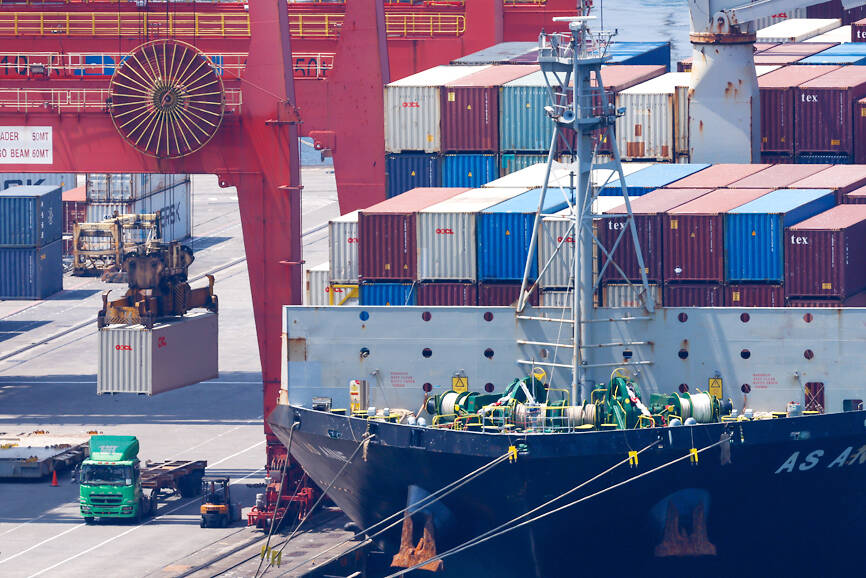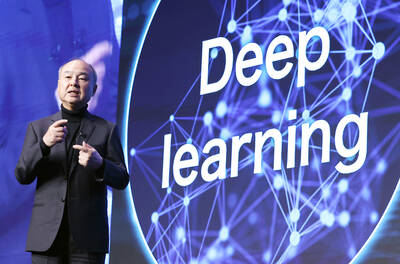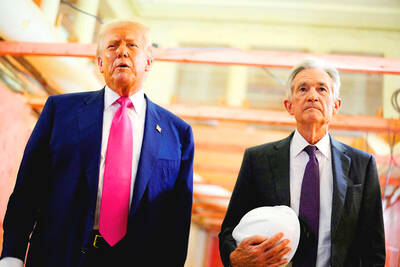Taiwan’s exports last month surged 42 percent year-on-year to an all-time high of US$56.68 billion, the fastest pace since 2010, as demand for artificial intelligence (AI) and high-performance computing (HPC) products outweighed tariff concerns and buoyed global technology supply chains, the Ministry of Finance said yesterday.
Shipments marked a third straight monthly record and extended a 21-month expansion streak, powered by the proliferation of AI and HPC applications and robust client restocking after the US extended a “reciprocal” tariff grace period, Department of Statistics Director-General Beatrice Tsai (蔡美娜) said.
Momentum is expected to hold through the third quarter, with this month’s exports forecast to rise by 17 to 22 percent, defying a projected contraction issued in May by the Directorate-General of Budget, Accounting and Statistics, Tsai said.

Photo: Ritchie B. Tongo, EPA
The statistics agency is likely to raise its GDP growth forecast when it meets on Friday next week, she said.
Electronics remained the main growth driver, with shipments of components climbing 34.1 percent and information and communications technology products soaring 87 percent year-on-year. Together, they rose 59.8 percent and made up 75.2 percent of total exports.
The US retained its position as Taiwan’s top export destination for the third consecutive month, taking a 32.9 percent share and displacing China, as the AI boom reshapes seasonal patterns in technology demand.
Exports to ASEAN surged 71.6 percent to US$11.63 billion, narrowing the gap with shipments to China at US$14.37 billion, amid global supply chain realignment, Tsai said.
Non-technology sectors continued to lag, with plastics and base metal exports down 1.8 percent and 4.6 percent respectively, suggesting an uneven recovery that is likely to persist, she said.
Imports jumped 20.8 percent to US$42.34 billion — the second-highest monthly level — on active purchases of semiconductor equipment and components for AI applications. That left Taiwan with a record trade surplus of US$14.34 billion, nearly triple that of a year earlier, the ministry said.
Cumulative trade surpluses with the US in the first seven months have already exceeded the total for all of last year, Tsai said, prompting Washington to impose a 20 percent tariff on Taiwanese imports.
The levy could trim US-bound shipments by 9 percent to 12 percent, mostly in non-technology goods, Tsai said, citing academic research.
It is too early to assess the impact of a separate 100 percent US tariff on semiconductors, she said, adding that exemptions would apply to companies with existing or planned manufacturing facilities in the US.
“There is little upon which to make assumptions until the White House announces more details,” Tsai said.
From January to last month, Taiwan’s exports rose 28.3 percent to US$339.94 billion, while imports gained 20.5 percent to US$269.89 billion. Both full-year figures are on track to set new records despite an expected slowdown in the second half as front-loading activity subsides, she said.

IN THE AIR: While most companies said they were committed to North American operations, some added that production and costs would depend on the outcome of a US trade probe Leading local contract electronics makers Wistron Corp (緯創), Quanta Computer Inc (廣達), Inventec Corp (英業達) and Compal Electronics Inc (仁寶) are to maintain their North American expansion plans, despite Washington’s 20 percent tariff on Taiwanese goods. Wistron said it has long maintained a presence in the US, while distributing production across Taiwan, North America, Southeast Asia and Europe. The company is in talks with customers to align capacity with their site preferences, a company official told the Taipei Times by telephone on Friday. The company is still in talks with clients over who would bear the tariff costs, with the outcome pending further

NEGOTIATIONS: Semiconductors play an outsized role in Taiwan’s industrial and economic development and are a major driver of the Taiwan-US trade imbalance With US President Donald Trump threatening to impose tariffs on semiconductors, Taiwan is expected to face a significant challenge, as information and communications technology (ICT) products account for more than 70 percent of its exports to the US, Chung-Hua Institution for Economic Research (CIER, 中華經濟研究院) president Lien Hsien-ming (連賢明) said on Friday. Compared with other countries, semiconductors play a disproportionately large role in Taiwan’s industrial and economic development, Lien said. As the sixth-largest contributor to the US trade deficit, Taiwan recorded a US$73.9 billion trade surplus with the US last year — up from US$47.8 billion in 2023 — driven by strong

AI: Softbank’s stake increases in Nvidia and TSMC reflect Masayoshi Son’s effort to gain a foothold in key nodes of the AI value chain, from chip design to data infrastructure Softbank Group Corp is building up stakes in Nvidia Corp and Taiwan Semiconductor Manufacturing Co (TSMC, 台積電), the latest reflection of founder Masayoshi Son’s focus on the tools and hardware underpinning artificial intelligence (AI). The Japanese technology investor raised its stake in Nvidia to about US$3 billion by the end of March, up from US$1 billion in the prior quarter, regulatory filings showed. It bought about US$330 million worth of TSMC shares and US$170 million in Oracle Corp, they showed. Softbank’s signature Vision Fund has also monetized almost US$2 billion of public and private assets in the first half of this year,

POWELL SUCCESSOR: US Fed Governor Adriana Kugler’s resignation gives Donald Trump an opening on the board, potentially accelerating his decision on the next chair US President Donald Trump suddenly has a chance to fill an opening at the US Federal Reserve earlier than expected, after Fed Governor Adriana Kugler announced her resignation on Friday. It might also force him to pick the next Fed chair months sooner than he had anticipated. “The ball is now in Trump’s court,” LH Meyer/Monetary Policy Analytics Inc economist Derek Tang said. “Trump is the one who’s been putting pressure on the Fed to do this and that, and Trump says he wants to have his own people on. So now he has the opportunity.” Kugler’s exit unfolds amid unprecedented public pressure